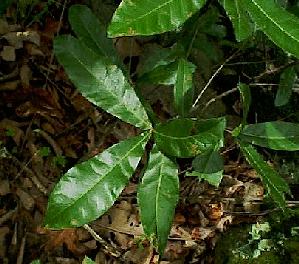
Tree to 20 m (65ft) tall. Bark brown, smoothish, becoming darker with low ridges and shallow fissures on lower trunk and older branches. Twigs slender, lustrous brown, glabrous, ending in a cluster of small shiny-scaled buds. Leaves alternate, lanceolate to oblong, 8-15 cm (3.1-6 in) long and 2-5 cm (0.8-2 in) wide, unlobed, entire and with a single bristle at apex, shiny dark green above, paler and sparsely tomentose below. Fruits are acorns maturing in the second year, nearly round, about 1.5 cm (0.6 in) in diameter, with cup enclosing 1/3 to 1/2.
Distribution: Native to much of the eastern United States except for the coastal plain.
Habitat: usually found in bottomland forests
NWI status: FAC
Comment: Apparent hybrids between Q. nigra and Q. phellos are sometimes found where the two species occur together, and have leaves that fit the description of those of Q. imbricaria. The lumber is marketed as red oak. Quercus is the ancient classical name for the European oaks; imbricaria means "overlapping", as with shingles.
Distribution in Oklahoma: Shingle oak has been reported for the northeastern corner of the state, but no specimens have been deposited in thr Bebb Herbarium.
BACK
NEXT
RETURN TO INDEX
Last update: 9/16/99
 Go to Oklahoma Biological Survey Home Page
Go to Oklahoma Biological Survey Home Page
 Disclaimer
Disclaimer